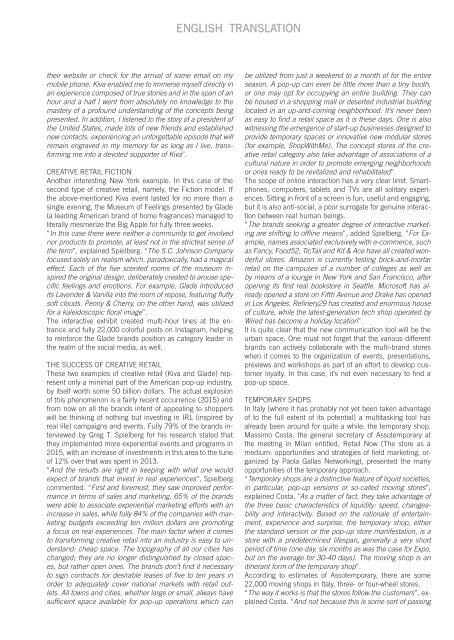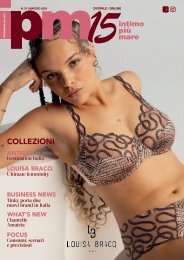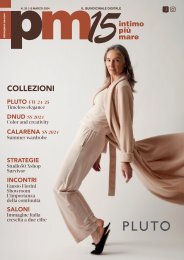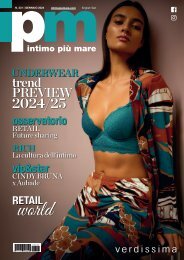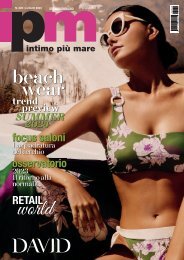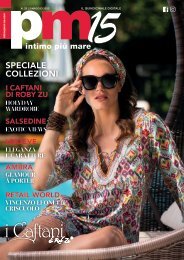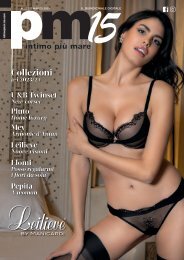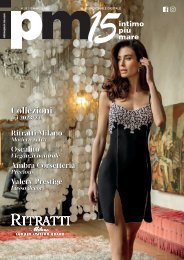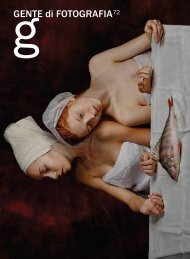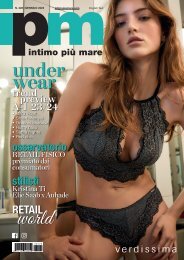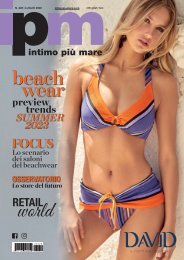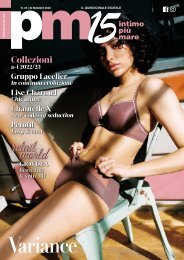Create successful ePaper yourself
Turn your PDF publications into a flip-book with our unique Google optimized e-Paper software.
ENGLISH TRANSLATION<br />
their website or check for the arrival of some email on my<br />
mobile phone. Kiva enabled me to immerse myself directly in<br />
an experience composed of true stories and in the span of an<br />
hour and a half I went from absolutely no knowledge to the<br />
mastery of a profound understanding of the concepts being<br />
presented. In addition, I listened to the story of a president of<br />
the United States, made lots of new friends and established<br />
new contacts, experiencing an unforgettable episode that will<br />
remain engraved in my memory for as long as I live, transforming<br />
me into a devoted supporter of Kiva”.<br />
CREATIVE RETAIL FICTION<br />
Another interesting New York example. In this case of the<br />
second type of creative retail, namely, the Fiction model. If<br />
the above-mentioned Kiva event lasted for no more than a<br />
single evening, the Museum of Feelings presented by Glade<br />
(a leading American brand of home fragrances) managed to<br />
literally mesmerize the Big Apple for fully three weeks.<br />
“In this case there were neither a community to get involved<br />
nor products to promote, at least not in the strictest sense of<br />
the term”, explained Spielberg. “The S.C. Johnson Company<br />
focused solely on realism which, paradoxically, had a magical<br />
effect. Each of the five scented rooms of the museum inspired<br />
the original design, deliberately created to arouse specific<br />
feelings and emotions. For example, Glade introduced<br />
its Lavender & Vanilla into the room of repose, featuring fluffy<br />
soft clouds. Peony & Cherry, on the other hand, was utilized<br />
for a kaleidoscopic floral image”.<br />
The interactive exhibit created multi-hour lines at the entrance<br />
and fully 22,000 colorful posts on Instagram, helping<br />
to reinforce the Glade brands position as category leader in<br />
the realm of the social media, as well.<br />
THE SUCCESS OF CREATIVE RETAIL<br />
These two examples of creative retail (Kiva and Glade) represent<br />
only a minimal part of the American pop-up industry,<br />
by itself worth some 50 billion dollars. The actual explosion<br />
of this phenomenon is a fairly recent occurrence (2015) and<br />
from now on all the brands intent of appealing to shoppers<br />
will be thinking of nothing but investing in IRL (inspired by<br />
real life) campaigns and events. Fully 79% of the brands interviewed<br />
by Greg T. Spielberg for his research stated that<br />
they implemented more experiential events and programs in<br />
2015, with an increase of investments in this area to the tune<br />
of 12% over that was spent in 2013.<br />
“And the results are right in keeping with what one would<br />
expect of brands that invest in real experiences”, Spielberg<br />
commented. “First and foremost, they saw improved performance<br />
in terms of sales and marketing. 65% of the brands<br />
were able to associate experiential marketing efforts with an<br />
increase in sales, while fully 84% of the companies with marketing<br />
budgets exceeding ten million dollars are promoting<br />
a focus on real experiences. The main factor when it comes<br />
to transforming creative retail into an industry is easy to understand:<br />
cheap space. The topography of all our cities has<br />
changed; they are no longer distinguished by closed spaces,<br />
but rather open ones. The brands don’t find it necessary<br />
to sign contracts for desirable leases of five to ten years in<br />
order to adequately cover national markets with retail outlets.<br />
All towns and cities, whether large or small, always have<br />
sufficient space available for pop-up operations which can<br />
be utilized from just a weekend to a month of for the entire<br />
season. A pop-up can even be little more than a tiny booth,<br />
or one may opt for occupying an entire building. They can<br />
be housed in a shopping mall or deserted industrial building<br />
located in an up-and-coming neighborhood. It’s never been<br />
as easy to find a retail space as it is these days. One is also<br />
witnessing the emergence of start-up businesses designed to<br />
provide temporary spaces or innovative new modular stores<br />
(for example, ShopWithMe). The concept stores of the creative<br />
retail category also take advantage of associations of a<br />
cultural nature in order to promote emerging neighborhoods<br />
or ones ready to be revitalized and rehabilitated”.<br />
The scope of online interaction has a very clear limit. Smartphones,<br />
computers, tablets and TVs are all solitary experiences.<br />
Sitting in front of a screen is fun, useful and engaging,<br />
but it is also anti-social, a poor surrogate for genuine interaction<br />
between real human beings.<br />
“The brands seeking a greater degree of interactive marketing<br />
are shifting to offline means”, added Spielberg. “For Example,<br />
names associated exclusively with e-commerce, such<br />
as Fancy, Food52, TicTail and Kit & Ace have all created wonderful<br />
stores. Amazon is currently testing brick-and-mortar<br />
retail on the campuses of a number of colleges as well as<br />
by means of a lounge in New York and San Francisco, after<br />
opening its first real bookstore in Seattle. Microsoft has already<br />
opened a store on Fifth Avenue and Drake has opened<br />
in Los Angeles. Refinery29 has created and enormous house<br />
of culture, while the latest-generation tech shop operated by<br />
Wired has become a holiday location”.<br />
It is quite clear that the new communication tool will be the<br />
urban space. One must not forget that the various different<br />
brands can actively collaborate with the multi-brand stores<br />
when it comes to the organization of events, presentations,<br />
previews and workshops as part of an effort to develop customer<br />
loyalty. In this case, it’s not even necessary to find a<br />
pop-up space.<br />
TEMPORARY SHOPS<br />
In Italy (where it has probably not yet been taken advantage<br />
of to the full extent of its potential) a multitasking tool has<br />
already been around for quite a while: the temporary shop.<br />
Massimo Costa, the general secretary of Assotemporary at<br />
the meeting in Milan entitled, Retail Now (The store as a<br />
medium: opportunities and strategies of field marketing, organized<br />
by Paola Gallas Networking), presented the many<br />
opportunities of the temporary approach.<br />
“Temporary shops are a distinctive feature of liquid societies,<br />
in particular, pop-up versions or so-called moving stores”,<br />
explained Costa. "As a matter of fact, they take advantage of<br />
the three basic characteristics of liquidity: speed, changeability<br />
and interactivity. Based on the rationale of entertainment,<br />
experience and surprise, the temporary shop, either<br />
the standard version or the pop-up store manifestation, is a<br />
store with a predetermined lifespan, generally a very short<br />
period of time (one day, six months as was the case for Expo,<br />
but on the average for 30-40 days). The moving shop is an<br />
itinerant form of the temporary shop”.<br />
According to estimates of Assotemporary, there are some<br />
22,000 moving shops in Italy, three- or four-wheel stores.<br />
“The way it works is that the stores follow the customers”, explained<br />
Costa. “And not because this is some sort of passing


